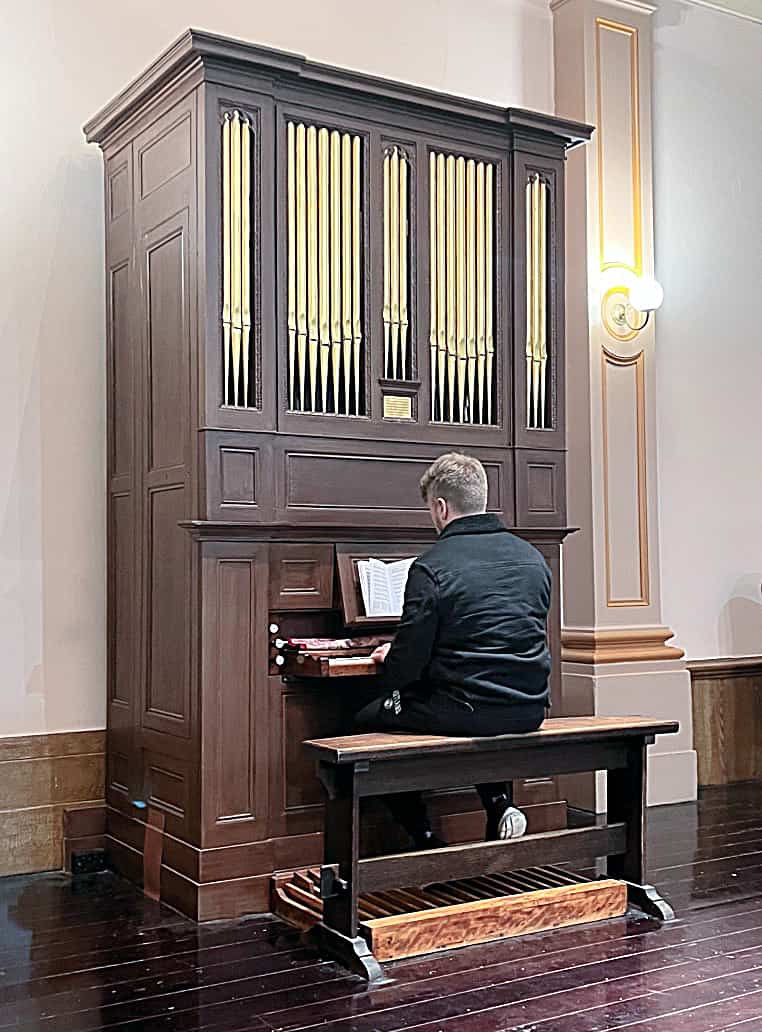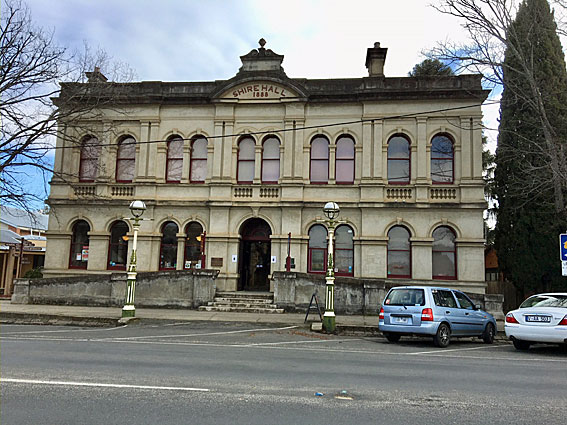
Beechworth Town Hall: exterior
[photograph by John Maidment (15 July 2018)]

Beechworth Town Hall
[photograph by Trevor Bunning (October 2023)]
Historical and Technical Documentation by John Maidment
© OHTA 2016, 2018 (last updated August 2018)

Beechworth Town Hall: exterior
[photograph by John Maidment (15 July 2018)]

Beechworth Town Hall
[photograph by Trevor Bunning (October 2023)]
Beechworth Town Hall dates back to 1859. Designed by architects J.J. Coe and Thomas Dalziel, it was built in granite by local contractors Donald and William Fiddes. This served not only as a public hall, but also as a courthouse, with cells beneath – these still survive. In 1889, the original front to the building (erected in 1858) was replaced by a new two-storey section designed by George Jobbins and built by Thomas Sandham.1 The hall consist of five bays intersected by pilasters and is designed in a classical idiom. It provides a lively acoustic for the organ.

Beechworth Town Hall: organ
[photograph by Mark Stephens (3 August 2018)]
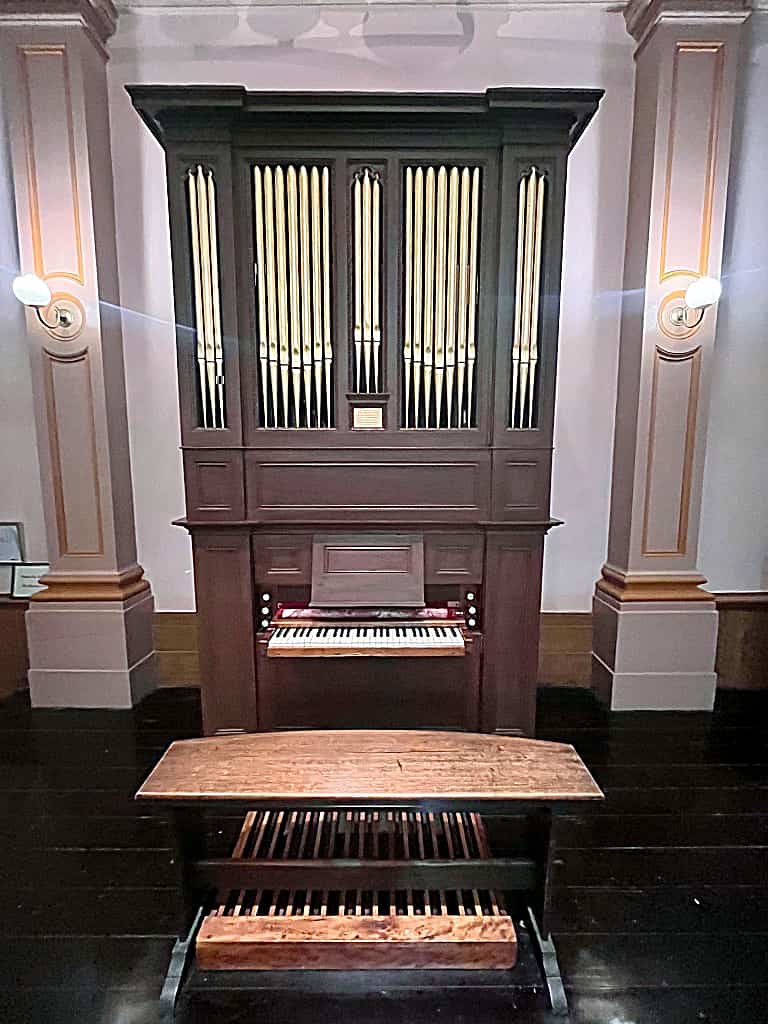
Beechworth Town Hall: organ
[photograph by Trevor Bunning (October 2023)]
The single manual chamber organ is of English origin. The design of its classical-style casework and console would date it from the mid-19th century. It has no identification of builder: the original nameplate has been removed. Ordered by the Beechworth Philharmonic Society, it was located at Beechworth Town Hall, in north-eastern Victoria, where it was first used in a concert on 20 December 1886.2 It is understood to have been supplied secondhand and installed by William Anderson, who placed an organ in Christ Church, Beechworth in the following year. It is shown in a photograph taken during a concert at the Town Hall, sited beneath a massive wooden pediment. It remained in Beechworth until June 1907. It appears that is was bought back by William Anderson at a cost of £20.00.

Beechworth Town Hall: organ and choir
[photograph from the Burke Museum]

St James' Anglican Church, Dandenong: interior showing organ to the right
[photograph from the St James' archives, courtesy of Jeremy Smith]
The organ was installed by Anderson at St James' Anglican Church, Dandenong in 1915 at a cost of £100. It was displaced by the Gray & Davison organ from St Patrick's Cathedral, Ballarat in 1931.

St Alban's Anglican Church, North Melbourne: organ
[photograph by John Maidment (22 April 2016)]
It was then installed at St Alban's Church by C.W. Andrewartha who made alterations to the Pedal Organ, adding on tubular-pneumatic action 12 pipes to form a Bourdon 16ft and also 12 zinc pipes to complete the compass of the Open Diapason 8ft.3 It was restored in 1988 by Australian Pipe Organs Pty Ltd at which stage the organ was moved from an alcove to the left of the chancel to a position in the north transept. The swell shutters, swell pedal, blowing pedal and composition pedals were removed. Thick dark varnish was refinished in a lighter colour. The dummy wooden façade pipes, covered in blue paint, were gilded, and the action and pipework overhauled. The pedalboard appears to be an addition, with the organ raised on a plinth to accommodate it. The oak keyboard with scrolled cheeks appears to have originally been retractable. The openings in the upper organ case have delicate carved mouldings and there are diminutive carved pipe shades.

St Alban's Anglican Church, North Melbourne: case detail
[photograph by John Maidment (22 April 2016)]
The casework and console have similarities with the 1843 William Hill organ at Our Lady & St Wilfrid Catholic Church, Warwick Bridge, Cumberland, with an identical style of console and music desk:
| MANUAL Open Diapasion Stopd Diapason Bass Clarabella Treble Keraulophon Principal Fifteenth |
[8] [8] [8] [8] [4] [2] |
TC CC-BB TC TC |
Pedals permanently coupled to manual
Compass: 56/29
Mechanical key & stop action
2 wooden composition pedals (removed 1988)
Lever swell pedal (removed 1988)
Iron blowing pedal and aperture for blowing handle (removed 1988)4

Beechworth Town Hall: left stop jamb
[photograph by Trevor Bunning (October 2023)]

Beechworth Town Hall: right stop jamb
[photograph by Trevor Bunning (October 2023)]
The organ was sold to the Beechworth Organ Society in 2018. It was removed from St Alban's Church on 23 July 2018 and moved to Beechworth in the following days by Wakeley Pipe Organs Pty Ltd. The 12 zinc pipes for the extension to CC of the Open Diapasion [sic] and 12 wooden pipes CCC-BBB for the Pedal Bourdon added on tubular-pneumatic action in 1931 by C.W. Andrewartha, and the side casework extensions added in 1988 by Australian Pipe Organs Pty Ltd, have been removed on the return to Beechworth as they added considerably to the instrument's depth. The tubular-pneumatic action for these pipes has been removed and the 18 pipes of the Stopd Diapason and Clarabella that had been tubed off the windchest have been returned to their original location on the windchest.
This is one of the four oldest organs in Victoria, excluding barrel organs. The other instruments that precede it include an 1828 chamber organ at Camberwell built by James Bishop; the 1845 Bevington & Sons organ in the Lady Chapel at Holy Trinity Cathedral, Wangaratta; and parts of an organ at Our Saviour's Lutheran Church, Knoxfield. It sounds and looks absolutely charming back in its earlier location.
1. Plaque affixed to front of building
2. Ovens and Murray Advertiser, 18 December 1886, p.4
3. E.N. Matthews, Colonial Organs and Organbuilders. Carlton: Melbourne University Press, 1969, p.141
4. Specification and other details noted by John Maidment 1966, 1988, 2016, 2018
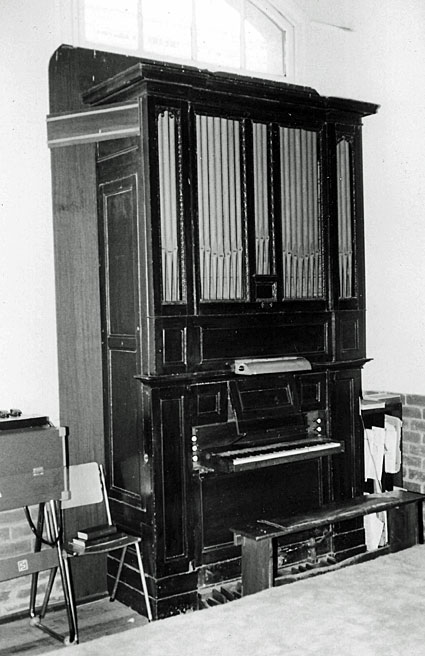
St Alban's Anglican Church, North Melbourne
[photograph by W.G.S. Smith (c.1970)]

St Alban's Anglican Church, North Melbourne: console detail
[photograph by W.G.S. Smith (c.1970)]

Beechworth Town Hall: organ viewed from right of stage
[photograph by Mark Stephens (3 August 2018)]
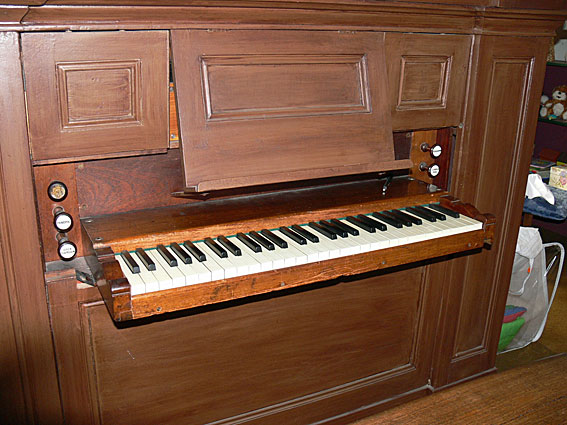
St Alban's Anglican Church, North Melbourne: console
[photograph by John Maidment (22 April 2016)]

Beechworth Town Hall: plaque in hall
[photograph by Trevor Bunning (October 2023)]
